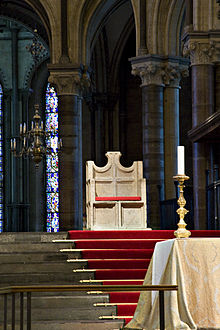- Chair of St Augustine
-
The Chair of St Augustine or Cathedra Augustini (Latin) represents one of the most ancient extant cathedrae in use.
History
Named for the first Archbishop of Canterbury, St Augustine of Canterbury, it is made of Purbeck Marble or Bethesda Marble and dates to sometime between the 6th and 12th centuries. Those who argue for an older date suggest that it may have been used to crown the kings of Kent. It has been in use since at least 1205.[1] Canterbury Cathedral, in which the cathedra is housed, maintains that the chair was once part of the furnishings of the shrine of St Thomas Becket, which was destroyed during the English Reformation.[2]
Since antiquity, it has always had a place in the triple enthronement of an Archbishop of Canterbury. He is seated on the throne in the quire as Diocesan Bishop, in the chapter house as titular abbot, and in St. Augustine's chair as Primate of All England. This is the only occasion in which the cathedra is used. A second one is used for other occasions in which the archbishop is present.
Modern meaning
Given the worldwide nature of the modern Anglican Communion, the enthronement in St Augustine's Chair has come to represent also the Archbishop of Canterbury's position as worldwide spiritual leader of the Communion; because of this it has become traditional for the enthronement in the Chair of St Augustine to be conducted by the senior Primatial Archbishop (by length of service in office) from around the world. For this reason the current Archbishop of Canterbury (Rowan Williams) was enthroned by the then (since retired) Archbishop of Armagh (Robin Eames). The first enthronement (in the quire cathedra) must, under English Law, be conducted by the Archdeacon of Canterbury.
References
- ^ article in Time Magazine
- ^ Canterbury Cathedral website
Categories:
Wikimedia Foundation. 2010.

